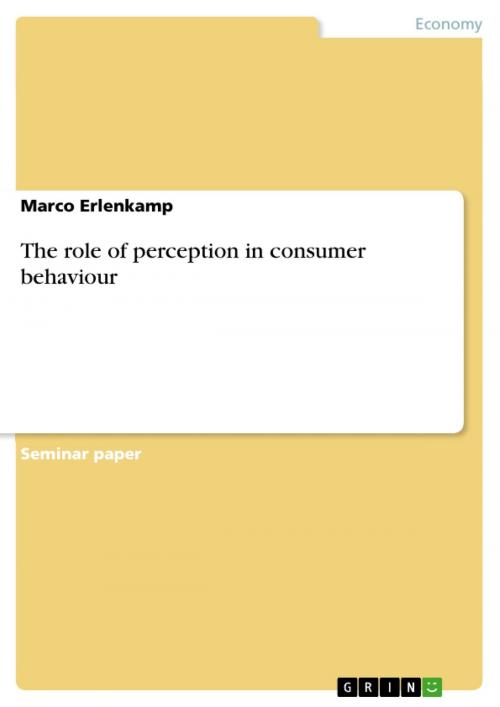| Author: | Marco Erlenkamp | ISBN: | 9783638486613 |
| Publisher: | GRIN Verlag | Publication: | April 6, 2006 |
| Imprint: | GRIN Verlag | Language: | English |
| Author: | Marco Erlenkamp |
| ISBN: | 9783638486613 |
| Publisher: | GRIN Verlag |
| Publication: | April 6, 2006 |
| Imprint: | GRIN Verlag |
| Language: | English |
Seminar paper from the year 2004 in the subject Business economics - Marketing, Corporate Communication, CRM, Market Research, Social Media, grade: 1,3, Galway Mayo Institute of Technology, course: Consumer Behaviour, 15 entries in the bibliography, language: English, abstract: Our modern world is very complex, and so is the business world. There are many things that influence the behaviour of the consumer. These influences can be religion, ethnic group, social class, age, gender, values, etc. But what is even more important than the different stimuli itself is how consumers perceive, process, interpret and store the stimuli. This work will describe what perception is, how consumers perceive and how this scheme can be used by marketers. What is perception? In general, perception is gathering information through our senses, which are seeing, hearing, touching, tasting, smelling and sensing. Through these senses we can perceive things, events or relations. But as there are so many different stimuli only a small portion of them are noticed and an even smaller amount can really reach our attention. And that's were it is necessary to talk about the difference between Sensation and perception. Although the distinction between sensation and perception is not that easy as it was believed in former times, a rough distinction can be made. Sensation is the immediate response of our sensory receptors to such basic stimuli as light, colour, etc. Perception is the process by which these stimuli are selected, organized and interpreted. When talking about perception we always have to keep in mind that we perceive the world not as it is, but as we think it is. That means that there are innumerable perceived worlds out there. This statement is based on the fact that every human being relates the observed world to its past experiences, its values, etc. Perception is more than just gathering information about a certain event at a certain time. It involves, recognizing stimuli, processing and storing them. The major challenge for the marketer is to identify the target customer and to find out, how this customer perceives the world. That will help to adjust all marketing activities to the target customer.
Seminar paper from the year 2004 in the subject Business economics - Marketing, Corporate Communication, CRM, Market Research, Social Media, grade: 1,3, Galway Mayo Institute of Technology, course: Consumer Behaviour, 15 entries in the bibliography, language: English, abstract: Our modern world is very complex, and so is the business world. There are many things that influence the behaviour of the consumer. These influences can be religion, ethnic group, social class, age, gender, values, etc. But what is even more important than the different stimuli itself is how consumers perceive, process, interpret and store the stimuli. This work will describe what perception is, how consumers perceive and how this scheme can be used by marketers. What is perception? In general, perception is gathering information through our senses, which are seeing, hearing, touching, tasting, smelling and sensing. Through these senses we can perceive things, events or relations. But as there are so many different stimuli only a small portion of them are noticed and an even smaller amount can really reach our attention. And that's were it is necessary to talk about the difference between Sensation and perception. Although the distinction between sensation and perception is not that easy as it was believed in former times, a rough distinction can be made. Sensation is the immediate response of our sensory receptors to such basic stimuli as light, colour, etc. Perception is the process by which these stimuli are selected, organized and interpreted. When talking about perception we always have to keep in mind that we perceive the world not as it is, but as we think it is. That means that there are innumerable perceived worlds out there. This statement is based on the fact that every human being relates the observed world to its past experiences, its values, etc. Perception is more than just gathering information about a certain event at a certain time. It involves, recognizing stimuli, processing and storing them. The major challenge for the marketer is to identify the target customer and to find out, how this customer perceives the world. That will help to adjust all marketing activities to the target customer.















